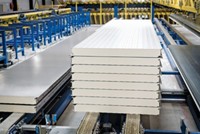Advertisement
Grab your lab coat. Let's get started
Welcome!
Welcome!
Create an account below to get 6 C&EN articles per month, receive newsletters and more - all free.
It seems this is your first time logging in online. Please enter the following information to continue.
As an ACS member you automatically get access to this site. All we need is few more details to create your reading experience.
Not you? Sign in with a different account.
Not you? Sign in with a different account.
ERROR 1
ERROR 1
ERROR 2
ERROR 2
ERROR 2
ERROR 2
ERROR 2
Password and Confirm password must match.
If you have an ACS member number, please enter it here so we can link this account to your membership. (optional)
ERROR 2
ACS values your privacy. By submitting your information, you are gaining access to C&EN and subscribing to our weekly newsletter. We use the information you provide to make your reading experience better, and we will never sell your data to third party members.
Environment
Green Chemical Standard's Potentially Broad Reach
New standard could benefit chemical makers and consumer products manufacturers by promoting information exchange
by Stephen K. Ritter
May 10, 2010
| A version of this story appeared in
Volume 88, Issue 19
The Greener Chemical Products & Processes Standard currently under development will provide a comprehensive multiattribute evaluation of the relative environmental performance of chemical products and manufacturing technologies. Its designers hope the standard will serve as a means for raw material suppliers, manufacturers, retailers, and consumers to share common information up and down the supply chain, with benefits to all stakeholders along the way.
Anne P. Wallin, Dow Chemical's director of sustainable chemistry, is participating in the effort. "At Dow, we are looking to use resources more efficiently, minimize our environmental footprint, provide value to our customers, and deliver solutions that meet their needs and enhance the quality of life of current and future generations. A standard that communicates these improvements throughout the value chain would be very helpful."
One area in which Dow could benefit is in promoting its propylene oxide production process, Wallin says. Dow is the world's leading producer of propylene oxide, a commodity chemical used to make polyurethane foams for steering wheels, mattresses, and shoe soles, and propylene glycols for cosmetics, paints, and aircraft deicers. In an effort to improve the environmental profile of its process, Dow developed a new hydrogen peroxide-to-propylene oxide (HPPO) technology in collaboration with BASF.
The process treats propylene with hydrogen peroxide in a gas-phase reaction over a titanium-containing zeolite catalyst to make propylene oxide with only water as a by-product. It's considered a greener reaction than the traditional chlorhydrin route that requires chlorine as a reactant and generates waste salt, or the hydroperoxide process that treats propylene with an alkyl reagent and produces organic coproducts. The first world-scale HPPO plant started up in 2008 in Belgium, and a second plant is being built in Thailand.
The HPPO process reduces wastewater by 70 to 80% and energy use by 35%, according to Dow statistics. And chemical plants that use the HPPO technology need up to 25% less capital cost to build than conventional chemical plants because they require less infrastructure. In addition, all the derivative products made from that propylene oxide carry sustainability advantages.
Dow gets to record those benefits internally on its accounting sheets, Wallin says. "But if we are trying to compel our customers with that information, they would rather have a third-party source, like the greener chemical standard, to validate those claims," she adds.
At the other end of the spectrum, Michael Kirschner, president of electronics manufacturing consulting firm Design Chain Associates, has a different situation with the IEEE 1680.1 standard, which guides the design of greener desktop and laptop computers and computer monitors. This standard covers parameters such as the use of hexavalent chromium and other environmentally sensitive substances, as well as the ease of disassembly and recycling electronic devices. It awards products a gold, silver, or bronze designation that is signified by an ecolabel.
"Manufacturers are now capable of delivering electronics products with improved environmental performance," Kirschner says. "The standard started out with virtually nothing in the silver and gold categories, and now there is virtually nothing in the bronze category. We will be revising the standard to set more stringent requirements and are currently expanding its scope to create criteria for scanners and printers and for televisions."
The greener chemical standard will be important for downstream companies such as electronic manufacturers that don't specify chemicals as ingredients for their products, he notes. Instead, they specify functionality such as a certain hardness, resistance to ultraviolet light, or color of a material such as a polymer. "But now that manufacturers want to specify that the material additionally shouldn't exceed a certain level of toxicity, say carcinogenicity or aquatic toxicity, then they are outside the bounds of where normal manufacturing industries have been."
The chemical company supplying the material needs to determine and share that information, he stipulates. "Having a standard will let the consumer weigh one product against another to determine which is better in terms of toxicity or which product is made by a greener process and by how much," Kirschner says. "Companies can start competing on those terms, and competition is what drives improvement."




Join the conversation
Contact the reporter
Submit a Letter to the Editor for publication
Engage with us on Twitter